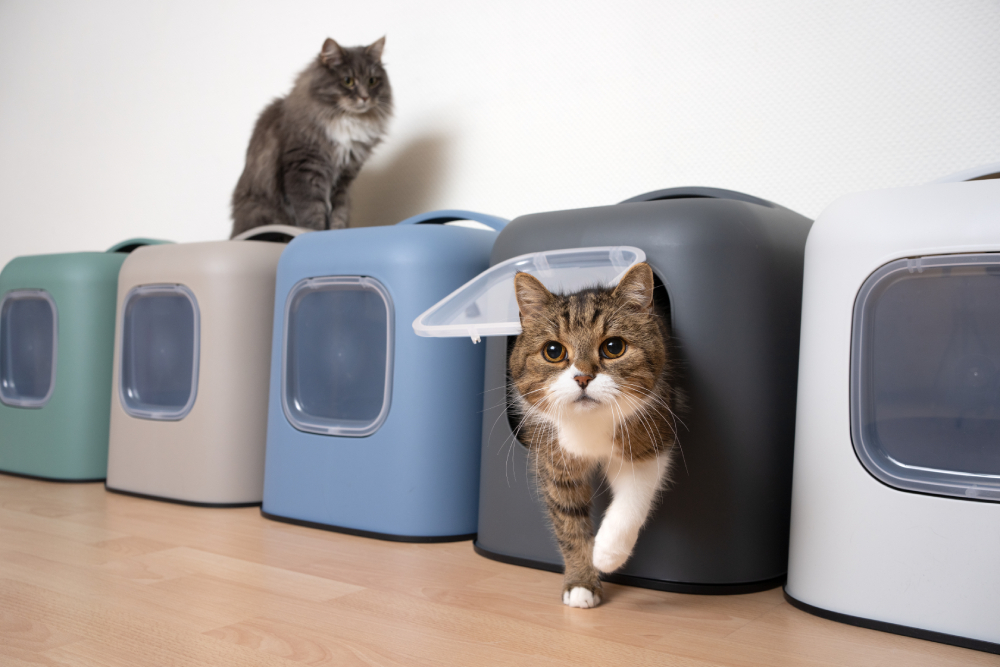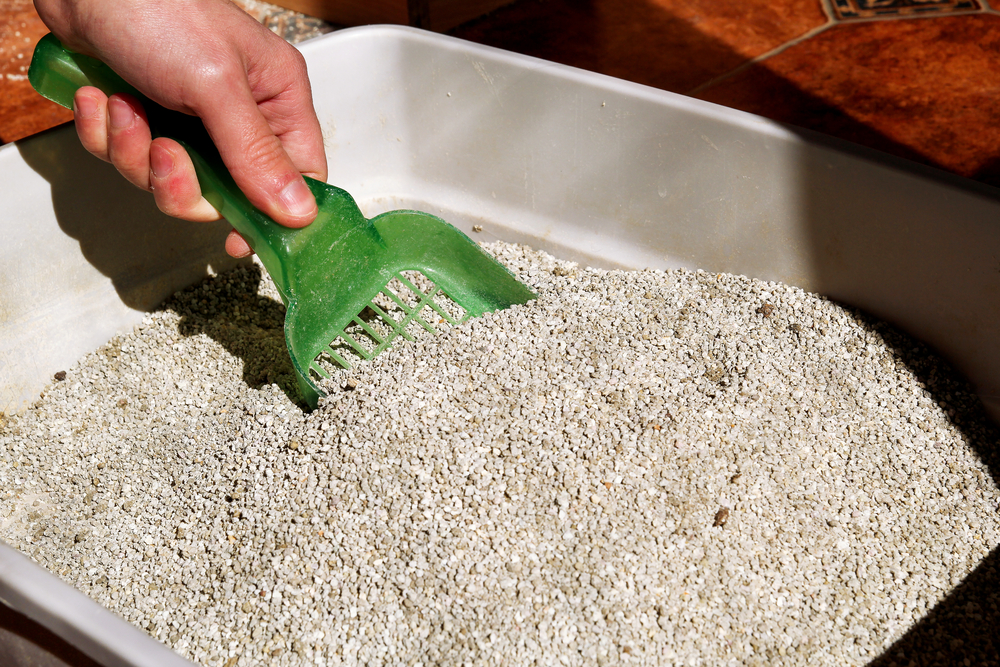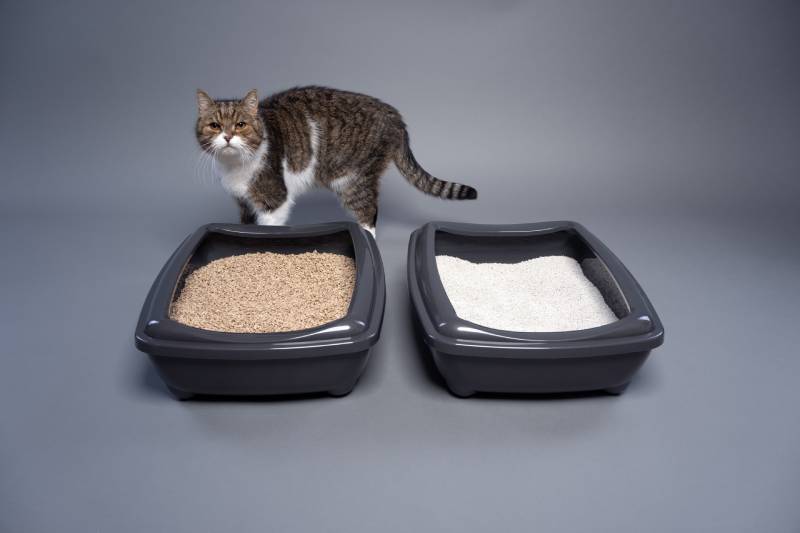Cats that live in the same home often adjust to sharing things, from toys and water bowls to beds and the favorite spot on the couch. The one thing that cats are sometimes unwilling to share, however, is litter boxes, particularly when two individuals have to “go” at the same time. The minimum number of litter boxes recommended for your house is one litter box per cat, plus an extra one.
For example, if you have one cat, you should have two litter boxes. If you have two cats, you should have three litter boxes, and so on. Some cats just don’t like to share their bathroom, and having their own plus a spare box ensures that they always have an option.

Why Do Cats Need Multiple Litter Boxes?
If you’ve ever had a roommate, you know how frustrating it can be if you only have one bathroom and it’s occupied. It’s similar for cats, except instead of just not being able to get in, they’re possibly dealing with a different level of hygiene than they prefer.
Healthy cats like to be clean. They spend a lot of time grooming themselves and covering up their pee and poop, so they may not be as comfortable sharing the dirty litter box space with another cat—one that may have different habits than their own.
Cats are also territorial. In some instances, one cat can block the litter box for another cat and create a situation where they don’t feel safe. When you have more than one litter box, this problem is circumvented, as all cats can have access to a litter box.
In addition, cats have different preferences for the environment concerning their litter box. For example, some cats like more privacy or quiet to do their business, so having another cat around can force them to choose another place, such as your carpet or bathtub.
Likewise, some cats have a litter box preference. For instance, one of your cats may have a preference for a covered box, while another would prefer an open box. The same can be said for litter itself, as some picky cats have a preference on litter type as well.
It isn’t uncommon for each cat to take to one litter box when presented with a choice. Though some owners loathe the idea of having to clean up multiple litter boxes, it’s actually advantageous to find yourself in this situation. Knowing which cat uses which litter box will help you identify when one particular cat is experiencing litter box or health issues. For instance, knowing which cat is using the litter box where you discover diarrhea lets you know which cat requires medical attention from a veterinarian for diarrhea. However, if all your cats share the same box (which also happens at times), this task becomes much more difficult.

Common Litter Box Problems
Some cats have no problem sharing, so their owners only keep one litter box for all of them. It may work for a while, but if your cats decide that they no longer want to share, they may act out in different ways:
- Marking the litter box: Some cats will spray the sides of the litter box or the wall near it to warn other cats away.
- Leaving waste uncovered: Some cats are inclined to cover their pee and poop in the litter box. If you notice that they’re not being as secretive as they once were, it could mean that one of your cats is claiming the litter box as their own.
- Resource guarding: In situations where feline aggression is involved, one individual may choose to guard the litter box of their choice and may try to prevent others from using it.
- Eliminating inappropriately: While there can be medical causes for soiling outside of the litter box suddenly, it could also indicate that your cat is not happy with the current litter box situation. It could be about sharing, or there could be other problems like too much noise in the area, a box they don’t like, or a litter type they don’t like.
Tips to Create Litter Box Harmony in Your Home
At times, you could run into challenges integrating multiple cats, even with multiple litter boxes. Here are some helpful tips:
- Scoop the litter box regularly—at least once a day. Your cat doesn’t like a dirty litter box anymore than you enjoy relieving yourself in a dirty public restroom.
- Replace litter and clean the litter box regularly. It is advised to replace the entire litter and clean a litter box thoroughly at least once a week.
- Place litter boxes in multiple spots to give your cat a choice. Having several different locations for litter boxes will allow your cats more freedom of choice.
- Cater to your cats’ needs. If one or more of your cats have mobility issues, make litter boxes more accessible for them. For example, an arthritic individual might not be comfortable climbing up steps to access a litter box.

Do I Really Need Two Litter Boxes for One Cat?
In a single-cat household, it’s not uncommon for your cat to settle on just one box. However, it is still recommended to have two boxes for your pet cat. Cats can be finicky and rely on a lot of instincts to ensure they’re safe, especially when they’re in a vulnerable situation, like relieving themselves. If you only have one litter box and something makes your cat uncomfortable, such as a running washing machine or a dog barking near the window, giving them another spot ensures they’ll use the litter box rather than other spots in your home.
This is also a good opportunity to test your cat’s preferences strategically. For example, you can try two different types of litter, different types of litter boxes, or different places in your home to see what your cat prefers. This makes it much easier to prevent litter box problems down the road.
Finally, it allows you more flexibility in your schedule. You can space out box cleaning duties if you have two boxes, whereas you don’t have this luxury if you only have one litter box. You’d also not want to run into a situation where your cat has to absolutely use the litter box when you’re busy cleaning it; having two boxes helps avoid accidents in such a scenario.
Even the best cat litter can quickly start smelling bad. To avoid the expense and inconvenience of constantly replacing your litter, you can try a great litter additive like Hepper's Advanced Bio-Enzyme Cat Litter Deodorizer, a natural product that uses bio-enzymes to neutralize odors.
- Bio Enzymatic Cat Litter Freshener - Smart formulation uses natural ingredients eliminating cat...
- Save Money - Stuff for cats isn’t the cheapest. With this litter box odor eliminator, you’ll...
- Every Litter, Every Surface - Are you afraid this additive won’t work on your litter? Fear not!...
This deodorizer works on all types of litter and won't disrupt your cat's litter box habits.
At Catster, we’ve admired Hepper for many years and decided to take a controlling ownership interest so that we could benefit from the outstanding designs of this cool cat company!

Conclusion
The golden rule is one litter box per cat plus an extra. While some cats are fine sharing, giving your cats their own space for this private activity is best, reducing the risk of conflict and litter box problems in multiple-cat homes.
Featured Image Credit: Nils Jacobi, Shutterstock











I have two cats and two litter boxes side by side
One of my cats is starting to pee on our indoor mat when we are away there’s always my son who visits and gives them treats
My question Why does only one litter tray get used
Hi Tracey,
Thank you for your question. It's not uncommon for cats to prefer one litter box over another, even if they’re placed side by side. Cats can be quite particular when it comes to their bathroom habits, and several factors like box cleanliness, location, or even stress can play a role.
We recommend checking out this article for more insights:
– https://www.catster.com/cat-health-care/how-many-litter-boxes-per-cat/
If your cat's behavior continues, you might want to consider booking an online consultation with one of our veterinarians to get personalized advice at Pangovet.com.
We hope this helps, and feel free to reach out with any other questions!